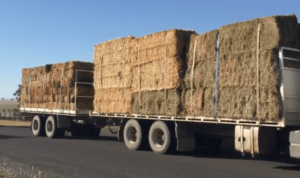Feed is more than just hay or grain, it is the energy and protein content that is most important.
It is critical to purchase feed that is appropriate for your stock and meets their nutritional requirements.
A simple visual assessment of a feed is not sufficient to determine quality.
By doing a ‘feed test’, you take the guess work out of feed supplementation and can accurately calculate the suitability of your feed.
A feed test will provide an analysis of the nutritional composition of your feed (be it hay, silage, grain or pasture). Metabolisable Energy (ME) is a critical component required by livestock and is one of the primary determinants of feed quality.
Different feeds are likely to have variations in energy content, for example hay tends to contain less ME than grains.
The energy content between 2 samples of the same type of feed can also vary.
While the difference can appear small on paper, doing some simple calculations suggests otherwise.
Below, is a comparison of 2 similar looking pasture hay samples, fed to a 550kg dry cow to achieve a maintenance energy requirement of 69MJ ME/day
| Hay 1 | Hay 2 | |
|---|---|---|
| Metabolisable Energy (ME) | 7.3 | 8.7 |
| Crude Protein (CP) | 5.9 | 14 |
| Dry Matter (DM %) | 89 | 86.9 |
| Neutral Detergent Fibre (NDF %) | 63.8 | 44.3 |
| Kg as fed | 10.6 | 9.1 |
Based on the feed test results, the cow requires 1.5 kg more of Hay 1 than Hay 2 to fulfill her maintenance energy requirements.
This can be further adjusted to account for herd size, the number of days of supplementary feeding, and even to accommodate a desired weight gain goal.
However, an apparently small difference in feed quality can have a large difference on the total amount of supplementary feed required.
If you fed the same 2 hay samples to a group of 100 cows at maintenance for 30 days, you would be feeding an additional 4.48 tonnes of Hay 1 as opposed to Hay 2.
This difference will increase further if the stock you are feeding had a higher daily ME requirement and were being fed for weight gain or lactation as opposed to maintenance.
It is important to note these calculations do not include wastage, so the amount fed will need to be higher. Wastage of hay fed on the ground is around 30% to 50%, while using hay feeders can reduce wastage to about 15%.
While this example doesn’t consider other factors that contribute to a balanced ration, it does highlight the impact of a higher-energy feed.
Importantly, the Crude Protein (CP) in Hay 1 is unlikely to meet the protein requirements of the cow in the above scenario. In this case, you would need to introduce another feed source with a higher protein level to meet this requirement.
Additionally, the higher Neutral Detergent Fibre (NDF) which is indicative of a higher roughage and lower quality feed, will limit the amount of feed the animals can physically consume and subsequently lower their energy intake. When feeding this stock class, aim for a CP of 10 or above and a NDF lower than 60%.
It’s important to note that nutritional requirements vary between animals and is influenced by a variety of factors including stock class, size, milk production and growth stage.
For example, a late pregnant heifer, will have a higher energy requirement compared to when she is in early pregnancy, in turn differs from her nutritional needs during lactation.
So, the next time you are buying feed, consider a feed test, crunch some numbers, and see for yourself which option will best meet you animal requirements and is more cost-effective in the longer term.
Source: Tanya Dobrijevic, Agriculture Victoria Ag Recovery Officer. For more information on feed testing visit www.feedinglivestock.vic.gov.au
